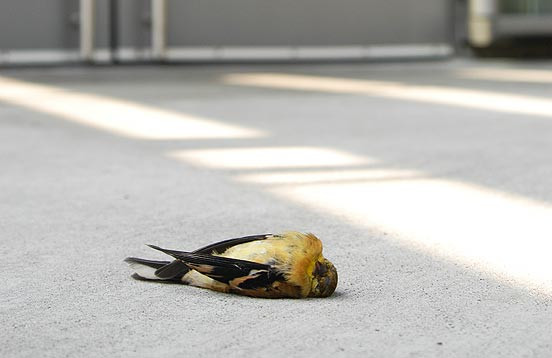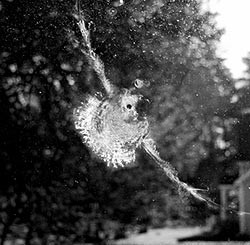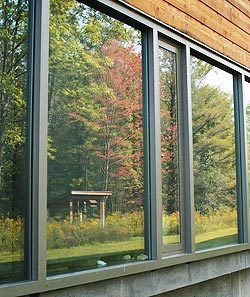Bird watching from your window can be a delightful pastime, but the heartbreaking thud of a bird hitting your window is anything but pleasant. Sadly, this is a widespread problem. Windows pose a significant threat to birds, often proving more dangerous than they appear. Reflecting sky and trees, glass surfaces become invisible barriers, leading to countless collisions. In fact, studies estimate that window strikes cause up to one billion bird deaths annually in the U.S. alone. This staggering number highlights the urgency of finding effective solutions.
Fortunately, making your home’s windows safer for birds is easier than you might think. According to Christine Sheppard, who leads the Bird Collisions Program at the American Bird Conservancy, simple remedies can significantly reduce this danger. Organizations like the American Bird Conservancy and the Fatal Light Awareness Program (FLAP) offer extensive resources and information on preventing bird collisions.
 american goldfinch killed by window strike
american goldfinch killed by window strike
A deceased American Goldfinch, a victim of a window strike, illustrating the deadly consequences of window collisions for birds.
Understanding Why Birds Hit Windows
The impact of a window collision can be fatal for birds. Even if a bird appears to fly away after a strike, it may succumb to internal injuries, bleeding, or brain trauma later. Daniel Klem, a researcher at Muhlenberg College who has studied this issue for decades, emphasizes that windows are indiscriminate killers, affecting healthy and vulnerable birds alike.
There are primarily two types of window collisions: daytime and nighttime strikes.
Daytime Collisions: During the day, birds collide with windows because they perceive reflections of surrounding vegetation or see through the glass to indoor plants or greenery on the other side. The reflected habitat creates an illusion of continuous flight space, leading birds directly into the glass.
 imprint of dove on plate glass window
imprint of dove on plate glass window
A window imprint left by a Mourning Dove after a collision, showing the force of impact and the unfortunate outcome.
Nighttime Collisions: At night, artificial lights pose a different threat, especially to nocturnal migrating birds like songbirds. Lights can disorient these birds, drawing them off course, particularly in foggy or low-ceiling conditions. Confused birds may circle in brightly lit areas, increasing the risk of collisions with buildings and windows. Moreover, birds attracted to urban lights at night may then face daytime window collision risks the following day due to reflections. Projects like BirdCast and the Fatal Light Awareness Program (FLAP) are dedicated to studying and mitigating this problem.
Territorial Attacks: Occasionally, birds may strike windows due to territorial behavior. Especially common in spring, birds may see their reflection and mistake it for a rival, leading them to attack. While this behavior can be bothersome, it is usually less dangerous to the bird. Interestingly, many solutions for general window strikes also deter these territorial attacks.
Effective Ways to Bird-Proof Your Windows
To protect birds from window collisions, the first step is to identify hazardous windows. Large picture windows, corner windows, and windows near bird feeders are often high-risk. Step outside your home and view your windows from a bird’s perspective. If you see reflections of trees, bushes, or sky, those windows are potential hazards. Contrary to older advice, feeder placement distance from windows is less critical than making the windows themselves bird-safe. If you have feeders near windows, prioritize treating the windows to prevent collisions.
 reflection of foliage in window – hazard to birds
reflection of foliage in window – hazard to birds
The reflection of trees and sky in a window creates a deceptive illusion of open space, a major cause of bird window strikes.
Practical Treatments for Existing Windows
For smaller birds, window markings should be spaced no more than 2 inches apart. For greater visibility, Acopian BirdSavers can be spaced up to 4 inches apart. Apply these treatments to the exterior window surface for maximum effectiveness.
- Tempera Paint or Soap: An economical and durable option is to use tempera paint or soap to mark the outside of your windows. Create a 2×2 inch grid pattern or design decorative patterns or artwork.
- Window Decals and Stickers: Apply decals, stickers, sun catchers, mylar strips, or even masking tape to the exterior of the glass. Ensure close spacing (as mentioned above) for effectiveness. Hawk silhouettes alone are not effective deterrents. A few stickers on a large window are insufficient; coverage across most of the glass is necessary to prevent collisions.
- Dot Patterns and Specialized Tapes: Long-lasting tapes with pre-spaced dot patterns offer a convenient way to achieve correct spacing. Products like Feather Friendly are designed specifically for bird collision prevention.
- Acopian BirdSavers (Zen Curtains): These consist of closely spaced cords hanging vertically in front of windows. They function similarly to tapes or decals but are easier to install and can be aesthetically pleasing. Highly effective, they are used at the Cornell Lab of Ornithology headquarters. You can purchase pre-made BirdSavers or create your own.
- Window Screens: Exterior mosquito screens covering the entire window surface are highly effective.
- Netting: Install netting on the outside, positioned at least 3 inches from the glass. The netting should be taut enough to deflect birds before impact. Small mesh netting (around 5/8″ or 1.6 cm) is ideal to prevent entanglement while ensuring birds bounce off safely. Mounting netting on frames, like storm window frames, allows for easy installation and removal.
- One-Way Transparent Film: Films such as Collidescape allow outward visibility from inside but appear opaque from the outside. These films can also reduce incoming light, potentially lowering cooling costs.
Planning for Bird-Safe Windows in New Homes and Remodels
For new construction or window replacements, consider these preventative measures:
- Exterior Shutters: Install external shutters and close them when rooms are unoccupied or when light and views are not needed. Shutters also offer significant energy savings.
- External Sun Shades or Awnings: Install awnings or sunshades to block sunlight reflection. Remote-controlled options are available for convenience.
- Full-Screen Windows: Opt for windows designed with screens covering the entire exterior glass surface.
- Interior Vertical Blinds: Use interior vertical blinds and keep slats partially closed.
- Minimize Visual Pathways: Avoid creating unobstructed views through your house to outdoor greenery or sky. Windows directly opposite each other can create the illusion of a clear flight path. Closing interior doors or using window shades can break these visual pathways.
Participate in Lights Out Initiatives
“Lights Out” programs are gaining momentum in cities across the U.S., including major urban centers. Excessive nighttime lighting in cities is particularly hazardous to migrating birds, drawing them off course, delaying migration, and increasing window collision risks. Reducing non-essential lighting and using downward-facing lights are simple yet effective steps to lessen light pollution at night. Homeowners should also adopt window safety measures, even with broader “Lights Out” efforts.
How to Assist a Bird That Has Hit a Window
If you find a bird that has collided with a window, immediate assistance is crucial for its recovery. Window collision victims may suffer hidden internal injuries that worsen over time. They are also vulnerable to predators. Here’s how to help:
- Capture and Contain: Approach the bird gently from behind and use both hands to carefully scoop it up. Hold it securely but gently, as small birds are fragile.
- Prepare a Container: Find an unwaxed paper bag or a small cardboard box lined with tissue or paper towel (for grip). Place the contained bird in a dark, quiet, warm, and safe location away from children and pets.
- Do Not Offer Food or Water: Avoid handling, feeding, or watering the bird to minimize stress. Wild birds perceive humans as threats.
- Locate a Wildlife Rehabilitator: Use an online directory to find a local wildlife rehabilitator and contact them for guidance and further instructions. If you cannot transport the bird, inform the facility about your limitations.
- Release (If Instructed): If the rehabilitator advises release, take the bird to a wooded area away from buildings. Before releasing, observe its flight ability. Open the container towards vegetation. If the bird doesn’t fly well, recapture it and contact the rehabilitator again for further advice.